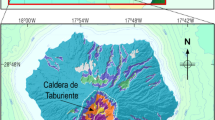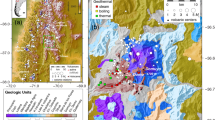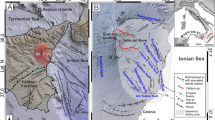Abstract
Surface deformation in volcanic areas usually indicates movement of magma or hydrothermal fluids at depth. Stratovolcanoes tend to exhibit a complex relationship between deformation and eruptive behaviour1. The characteristically long time spans between such eruptions requires a long time series of observations to determine whether deformation without an eruption is common at a given edifice. Such studies, however, are logistically difficult to carry out in most volcanic arcs, as these tend to be remote regions with large numbers of volcanoes (hundreds to even thousands). Here we present a satellite-based interferometric synthetic aperture radar (InSAR) survey of the remote central Andes volcanic arc, a region formed by subduction of the Nazca oceanic plate beneath continental South America. Spanning the years 1992 to 2000, our survey reveals the background level of activity of about 900 volcanoes, 50 of which have been classified as potentially active2,3. We find four centres of broad (tens of kilometres wide), roughly axisymmetric surface deformation. None of these centres are at volcanoes currently classified as potentially active, although two lie within about 10 km of volcanoes with known activity. Source depths inferred from the patterns of deformation lie between 5 and 17 km. In contrast to the four new sources found, we do not observe any deformation associated with recent eruptions of Lascar, Chile4,5.
This is a preview of subscription content, access via your institution
Access options
Subscribe to this journal
Receive 51 print issues and online access
$199.00 per year
only $3.90 per issue
Buy this article
- Purchase on Springer Link
- Instant access to full article PDF
Prices may be subject to local taxes which are calculated during checkout




Similar content being viewed by others
References
Dvorak, J. J. & Dzurisin, D. Volcano geodesy: The search for magma reservoirs and the formation of eruptive vents. Rev. Geophys. 35, 343–384 (1997)
de Silva, S. L. & Francis, P. W. Volcanoes of the Central Andes (Springer, New York, 1991)
Gonzalez-Ferran, O. Volcanes de Chile (in Spanish) (Instituto Geografico Militar, Santiago, Chile, 1995)
Matthews, S. J., Gardeweg, M. C. & Sparks, R. S. J. The 1984 to 1996 cyclic activity of Lascar Volcano, northern Chile: Cycles of dome growth, dome subsidence, and explosive eruptions. Bull. Volcanol. 59, 77–82 (1997)
Wooster, M. J. Long-term infrared surveillance of Lascar Volcano: Contrasting activity cycles and cooling pyroclastics. Geophys. Res. Lett. 28, 847–850 (2001)
Smithsonian Institution Global Volcanism Program. 〈http://nmnhwww.si.edu/gvp/〉 (accessed 29 April 2002).
Hanssen, R. A. Radar Interferometry: Data Interpretation and Error Analysis (Kluwer Academic, Dordrecht, The Netherlands, 2001)
Amelung, F., Jonsson, S., Zebker, H. & Segall, P. Widespread uplist and ‘trapdoor’ faulting on Galapagos volcanoes observed with radar interferometry. Nature 407, 993–996 (2000)
Sambridge, M. Exploring multi-dimensional landscapes without a map. Inverse Problems 14, 427–440 (1998)
Yuan, X. et al. Subduction and collision processes in the Central Andes constrained by converted seismic phases. Nature 408, 958–961 (2000)
Wigger, P. J. et al. in Tectonics of the Southern Central Andes: Structure and Evolution of an Active Continental Margin (eds Reutter, K.-J., Scheuber, E. & Wigger, P. J.) 23–48 (Springer, Berlin, 1994)
Williams, C. A. & Wadge, G. The effects of topography on magma chamber deformation models: Application to Mt. Etna and radar interferometry. Geophys. Res. Lett. 25, 1549–1552 (1998)
Johnston, M. J. S., Hill, D. P., Linde, A. T., Langbein, J. & Bilham, R. Transient deformation during triggered seismicity from the 28 June Mw = 7.3 Landers earthquake at Long-Valley caldera, California. Bull. Seismol. Soc. Am. 85, 787–795 (1995)
de Silva, S. L. Altiplano-Puna volcanic complex of the central Andes. Geology 17, 1102–1106 (1989)
Chmielowski, J., Zandt, G. & Haberland, C. The central Andean Altiplano-Puna magma body. Geophys. Res. Lett. 26, 783–786 (1999)
Lazo, M., Kosaka, A., Minaya, A., Gonzales, E. & Soto, J. in Proc. VII Congreso Peruano de Geologia 19–22 (Sociedad Geologica del Peru, Lima, 1991)
Curtis, G. H. in Studies in Volcanology, a Memoir in Honor of Howell Williams Geol. Soc. Mem. 116 (eds Coats, R. R., Hay, R. L. & Anderson, C. A.) 153–210 (GSA, Boulder, CO, 1968)
Simkin, T. & Siebert, L. Volcanoes of the World (Geoscience, Tucson, 1994)
Matthews, S. J., Sparks, R. S. J. & Gardeweg, M. C. Piedras Grandes-Soncor eruptions, Lascar volcano, Chile; evolution of zoned magma chamber in the central Andean upper crust. J. Petrol. 40, 1891–1919 (1999)
Matthews, S. J., Jones, A. P. & Gardeweg, M. C. Lascar volcano, northern Chile—Evidence for steady-state disequilibrium. J. Petrol. 35, 401–432 (1994)
Rymer, H., Murray, J. B., Brown, G. C., Ferrucci, F. & McGuire, W. J. Mechanisms of magma eruption and emplacement at Mt. Etna between 1989 and 1992. Nature 361, 439–441 (1993)
Fernandez, J., Tiampo, K. F., Jentzsch, G., Charco, M. & Rundle, J. B. Inflation or deflation? New results for Mayon volcano applying elastic-gravitational modeling. Geophys. Res. Lett. 28, 2349–2352 (2001)
Watanabe, H., Okubo, S., Sakashita, S. & Maekawa, T. Drain-back process of basaltic magma in the summit conduit detected by microgravity observation at Izu-Oshima volcano, Japan. Geophys. Res. Lett. 25, 2865–2868 (1998)
Thouret, J.-C. et al. Geomorphological and geological survey, and SPOT remote sensing of the current activity of Nevado Sabancaya stratovolcano (south Peru): assessment for hazard-zone mapping. Z. Geomorph. 39, 515–535 (1995)
Wooster, M. J. & Rothery, D. A. Thermal monitoring of Lascar Volcano, Chile, using infrared data from the along-track scanning radiometer: a 1992–1995 time series. Bull. Volcanol. 58, 566–579 (1997)
Acknowledgements
European Space Agency (ESA) remote-sensing satellite (ERS) synthetic aperture radar (SAR) imagery for this study was acquired as a Category 1 research project from the ESA. We thank A. Linde for a critical review, L. Rivera and R. Lohman for modelling software, S. de Silva for an electronic version of his volcano database, and H. Zebker, Y. Fialko, P. Segall, E. Brodsky and M. Battaglia for useful discussions. This material is based upon work partially supported by the National Science Foundation under a grant to M.S. M.E.P. was partly supported by NASA and NSF fellowships.
Author information
Authors and Affiliations
Corresponding author
Ethics declarations
Competing interests
The authors declare that they have no competing financial interests.
Rights and permissions
About this article
Cite this article
Pritchard, M., Simons, M. A satellite geodetic survey of large-scale deformation of volcanic centres in the central Andes. Nature 418, 167–171 (2002). https://doi.org/10.1038/nature00872
Received:
Accepted:
Issue Date:
DOI: https://doi.org/10.1038/nature00872
This article is cited by
-
The centenary of IAVCEI 1919–2019 and beyond: The people, places, and things of volcano geodesy
Bulletin of Volcanology (2022)
-
Strengthening local volcano observatories through global collaborations
Bulletin of Volcanology (2022)
-
Advances in scientific understanding of the Central Volcanic Zone of the Andes: a review of contributing factors
Bulletin of Volcanology (2022)
-
The dynamics of large silicic systems from satellite remote sensing observations: the intriguing case of Domuyo volcano, Argentina
Scientific Reports (2020)
-
How satellite InSAR has grown from opportunistic science to routine monitoring over the last decade
Nature Communications (2020)
Comments
By submitting a comment you agree to abide by our Terms and Community Guidelines. If you find something abusive or that does not comply with our terms or guidelines please flag it as inappropriate.



